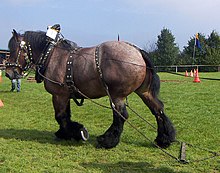Ardennais
 Ardennes stallion | |
| Other names |
|
|---|---|
| Country of origin |
|
| Traits | |
| Distinguishing features | Draft horse breed |
| Breed standards | |
The Ardennais or Ardennes is one of the oldest breeds of draft horse, and originates from the Ardennes area in Belgium, Luxembourg, and France. They are heavy-boned with thick legs and are used for draft work.
Their history reaches back to Ancient Rome, and throughout the years blood from several other breeds has been added to the Ardennes, although only the Belgian breed had any significant impact. The first Ardennes were imported to the United States in the early 20th century, and the first breed registry was established in Europe in 1929. The horses have been used throughout history as war horses, both as cavalry mounts and to draw artillery, and are used today mainly for heavy draft and farm work, meat production and competitive driving events. They have also been used to influence or create several other horse breeds throughout Europe and Asia.
History

Their history reaches back to
Percheron, Boulonnais and Thoroughbred blood were also added, although they had little impact.[5] In the nineteenth century, Belgian draft blood was added to give the breed the heavier conformation it has today.[1] The extra weight and size was desired to turn the breed into a very heavy draft breed, after their role as an artillery horse had diminished through the advent of mechanization, as well as a desire for a meat animal. The breed increased in size from an average of 550 kilograms (1,210 lb) to their current weight,[6] which at the same time had the consequence of reducing their vigor and endurance.[7] The first breed registry was established in Europe in 1929.[1] Today there are 3 separate studbooks in France, Belgium and Luxembourg, although there is extensive interbreeding between all three. The Ardennes Horse Society of Great Britain was also formed in the late 20th century to preserve and promote Ardennes horses in Great Britain,[6] but today is not recognized as a studbook or passport issuing organization by the British government[8] and may not exist in any form.
The first Ardennes were imported to the United States in the early 20th century, but it is still not known precisely when. Originally, when imported to the United States, Ardennes horses were eligible for registration with the now-defunct National French Draft Horse Association of America[9] or French Draft Horse Society. This organization published a stud book and registered six individual French draft breeds as belonging to a single breed, combining the information so that no totals of individual breeds are known. Many of these horses were imported to the United States with their breed being considered simply "French draft" and no individual type being specified.[10] Some Ardennes horses imported to the United States before 1917 were called Belgians when they were imported and subsequently registered as Belgians.[11] Ardennes horses have continued to be imported into the United States from Belgium, with imports occurring as late as 2004.[12]
Characteristics
In France, Ardennes stallions stand about 1.62 metres (16
Uses

Horses from the Ardennes region were used as
Today, the breed is used mainly for meat, due to its extensive musculature.
Ardennes horses have been used as
References
- ^ ISBN 0-671-66068-3.
- ^ Hewitt, Mrs J.C. (October 1998). "A Brief History of the Ardennes Horse". The Joy of Horses. Archived from the original on 19 May 2009. Retrieved 15 September 2009.
- ^ a b c d "Ardennes". Oklahoma State University. Archived from the original on 29 November 2007. Retrieved 14 December 2007.
- ^ Moll, Louis; Gayot, Eugène Nicolas (1861). La connaissance générale du cheval : études de zootechnie pratique, avec un atlas de 160 pages et de 103 figures (in French). Didot. p. 545.
- ^ ISBN 1-56458-614-6.
- ^ ISBN 0-85236-401-6.
- ^ ASIN B000UEYZHA.
- ^ "Horse passports- organisations issuing horse passports" (PDF). Department for Environment, Food and Rural Affairs. 31 August 2011. Archived from the original (PDF) on 23 December 2011. Retrieved 5 November 2011.
- ^ Bailey, Liberty Hyde (1910). Cyclopedia of American Agriculture:A Popular Survey of Agricultural Conditions, Practices and Ideals in the United States and Canada (3rd ed.). Macmillan. pp. 460–461.
- ^ Harper, Merritt Wesley (1913). Management and Breeding of Horses. Orange Judd Co. p. 183.
Ardennais horse united states.
- ^ Annual Report. New York (State) Dept. of Agriculture. 1917. p. 73.
- ^ "Horses of a Different Culture". St. Petersburg Times Online. 18 June 2004. Retrieved 23 June 2009.
- ^ a b L'Ardennais Union des éleveurs de chevaux de la race ardennaise. Les Haras Nationaux, 2010. (in French) Accessed August 2011 "The Ardennais"
- ^ Standard de la race Stud-Book du Cheval de Trait Ardennais (in French) Accessed August 2011 "Breed standard"
- ISBN 1-59228-990-8.
- ISBN 0-8153-3351-X.
- ^ Johnson, Michael (19 June 2008). "Hungry for Horse Meat". New York Times. Retrieved 16 September 2009.
- ISBN 0-671-66068-3.
- ASIN B000UEYZHA.
Related articles
- Pfalz-ardenner
